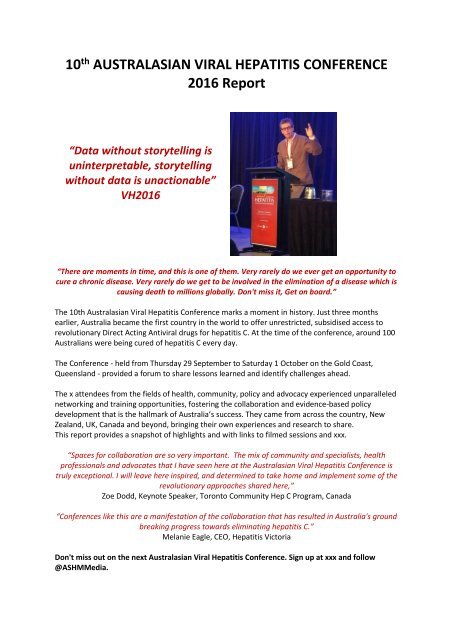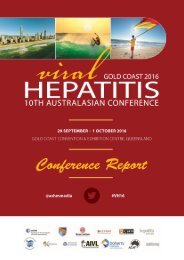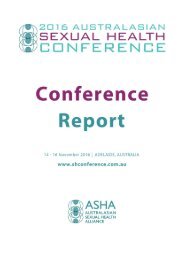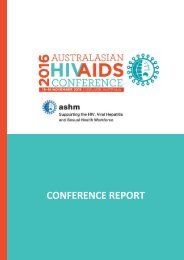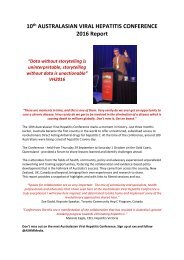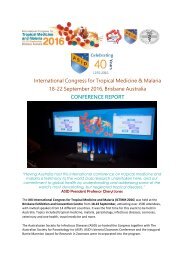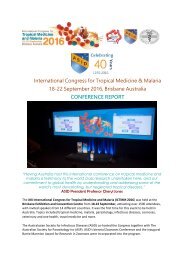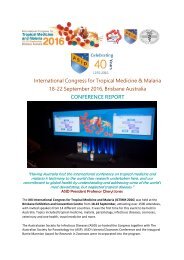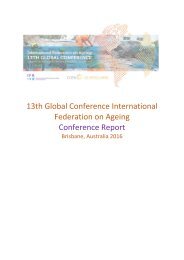You also want an ePaper? Increase the reach of your titles
YUMPU automatically turns print PDFs into web optimized ePapers that Google loves.
10 th AUSTRALASIAN VIRAL HEPATITIS CONFERENCE<br />
<strong>2016</strong> Report<br />
“Data without storytelling is<br />
uninterpretable, storytelling<br />
without data is unactionable”<br />
<strong>VH</strong><strong>2016</strong><br />
“There are moments in time, and this is one of them. Very rarely do we ever get an opportunity to<br />
cure a chronic disease. Very rarely do we get to be involved in the elimination of a disease which is<br />
causing death to millions globally. Don't miss it, Get on board.”<br />
The 10th Australasian Viral Hepatitis Conference marks a moment in history. Just three months<br />
earlier, Australia became the first country in the world to offer unrestricted, subsidised access to<br />
revolutionary Direct Acting Antiviral drugs for hepatitis C. At the time of the conference, around 100<br />
Australians were being cured of hepatitis C every day.<br />
The Conference - held from Thursday 29 September to Saturday 1 October on the Gold Coast,<br />
Queensland - provided a forum to share lessons learned and identify challenges ahead.<br />
The x attendees from the fields of health, community, policy and advocacy experienced unparalleled<br />
networking and training opportunities, fostering the collaboration and evidence-based policy<br />
development that is the hallmark of Australia’s success. They came from across the country, New<br />
Zealand, UK, Canada and beyond, bringing their own experiences and research to share.<br />
This report provides a snapshot of highlights and with links to filmed sessions and xxx.<br />
“Spaces for collaboration are so very important. The mix of community and specialists, health<br />
professionals and advocates that I have seen here at the Australasian Viral Hepatitis Conference is<br />
truly exceptional. I will leave here inspired, and determined to take home and implement some of the<br />
revolutionary approaches shared here,”<br />
Zoe Dodd, Keynote Speaker, Toronto Community Hep C Program, Canada<br />
“Conferences like this are a manifestation of the collaboration that has resulted in Australia's ground<br />
breaking progress towards eliminating hepatitis C.”<br />
Melanie Eagle, CEO, Hepatitis Victoria<br />
Don't miss out on the next Australasian Viral Hepatitis Conference. Sign up at xxx and follow<br />
@ASHMMedia.
Take Home Messages<br />
“We have been given the enormous good fortune of having access to these new hepatitis C<br />
medications. We are the only country in the world offering them to everyone without restriction. We<br />
must use them well, and we must use them wisely.”<br />
100 HUNDRED AUSTRALIANS CURED OF HEPATITIS C EVERY DAY<br />
Calls for increased health worker education and outreach to meet viral hepatitis elimination goals<br />
Australia is making great progress towards eliminating hepatitis C, with record numbers now being<br />
cured of the disease. The challenge now is how to effectively engage diverse populations in both<br />
prevention and treatment programs, and to overcome barriers in the health system preventing<br />
many people living with both hepatitis C and hepatitis B from coming forward for testing and<br />
treatment. Read the Australian Viral Hepatitis Conference media release<br />
SNAPSHOT: KEY MESSAGES FROM <strong>VH</strong> <strong>2016</strong><br />
<br />
<br />
<br />
We need a diversity of models of care to reach diverse populations. One size does NOT fit all.<br />
Stigma is killing people. Stigma and discrimination by the health work force is one of the<br />
most profound barriers to care for people with viral hepatitis.<br />
Engaging marginalized and “difficult-to-engage” populations is key.<br />
HCV<br />
<br />
<br />
<br />
<br />
<br />
<br />
<br />
<br />
The explosive uptake of HCV treatment will not be maintained.<br />
Expect to see reinfections. Make sure those who are reinfected aren’t stigmatised.<br />
Be prepared for viral resistance.<br />
HCV antibody testing is high in Australia, but there still exists a large undiagnosed HCV RNA<br />
pool and people are not linked to care.<br />
Enhanced screening is required in addition to new diagnostic tools such as Point of Care<br />
tests.<br />
The future of upscaling lies in primary care/community care.<br />
Successful components of interventions/models to enhance HCV testing/care need to be<br />
disseminated, shared and translated.<br />
Challenges: Cost of drugs, War on drugs, remote and rural communities, mental mental<br />
health co morbidity.<br />
MJA OPED LEVINIA CROOKS<br />
Health workforce discrimination undermines hepatitis C success<br />
AUSTRALIA is currently enjoying international acclaim<br />
for its revolutionary response to hepatitis C. Yet<br />
despite this success, stigma and discrimination by the<br />
health workforce threaten to prevent us from<br />
optimising these achievements. Read the Oped by<br />
Levinia Crooks
The Data: Surveillance Reports <strong>2016</strong><br />
<strong>VH</strong> <strong>2016</strong> delegates were the first to receive the latest national viral hepatitis statistics for Australia<br />
with the launch of the Kirby Institute’s Hepatitis B and C in Australia Annual Surveillance Report<br />
Supplement and the UNSW Centre for Social Research Annual Report of Trends in Behaviour<br />
Supplement <strong>2016</strong> on Viral Hepatitis.<br />
Kirby Surveillance Report<br />
National Statistics<br />
232 600 with HBV yet only 62% of those diagnosed and only 6% had received treatment.<br />
227 306 with HCV, with 82% diagnosed and 22% having received anti-viral treatment.<br />
HCV rates in Aboriginal and Torres Strait Islander population are 4 times greater than<br />
non-Indigenous population and have increased by 43% in the five past years. HBV rates<br />
were 3 times higher.<br />
The number of people with cirrhosis has doubled in a decade.<br />
HCV<br />
Close to 30 000 people were cured of HCV in the 3 months since subsidised DAAs were<br />
introduced in March <strong>2016</strong> – approximately 100 per day. Uptake has been particularly high in<br />
people with advanced liver disease.<br />
However, the vast majority of people with HCV remain at increased risk of serious liver<br />
disease without treatment.<br />
Priorities: HCV<br />
Increased diagnosis<br />
Expanded treatment coverage<br />
Prevention strategy scale up e.g. NSP that also reaches Aboriginal and Torres Strait Islander<br />
populations<br />
Priorities: HCV<br />
Scale up diagnosis and treatment<br />
Enhanced culturally specific strategies<br />
Priority populations: People from Asia and the Pacific, Aboriginal and Torres Strait Islander<br />
peoples, MSM engaged in high risk sexual activity and PWID.<br />
CSR Trends in Behaviour Report<br />
<br />
<br />
<br />
<br />
<br />
A mistrust of the health system and ongoing stigma from health workers against injecting<br />
drug users are two significant barriers to HCV treatment.<br />
Only 35% of gay and bisexual men aware of HCV cure.<br />
HIV status influenced their knowledge and attitudes.<br />
Suggests HCV education + prevention for gay men should be tailored according to HIV status<br />
HBV management in primary care would be improved through greater community-based<br />
outreach programs and education programs for health professionals.
In Focus – HCV Better Services<br />
PRESCRIBING IN PRIMARY CARE<br />
“All clinicians with the skills and experience to manage hepatitis C should be able to initiate<br />
treatment” Read ASHM’s Position Statement of Hepatitis C Prescribing.<br />
Key points from <strong>VH</strong>16<br />
<br />
<br />
<br />
<br />
<br />
<br />
<br />
Clinicians should be able to initiate treatment across the range of primary care settings:<br />
Aboriginal Medical Services, Drug and Alcohol Services, Sexual Health Services, youth,<br />
migrant, women's or men's health services, mental health services or corrections/juvenile<br />
justice services.<br />
Patients without advanced or complicated disease can be managed in primary care.<br />
All GPs need ongoing education in order to diagnose and treat or refer.<br />
Additional training and support is required for experienced and trained GPs to prescribe<br />
independently.<br />
There is significant scope for nurse-led care.<br />
Main barriers include education and access to FibroSCAN. A Victorian study by the Burnet<br />
Institute found most GPs were interested in prescribing DAAS but half did not know if active<br />
IDU were eligible for treatment and only 10 per cent had access to FibroSCAN. Clear ‘in<br />
consultation’ pathways were also required. Read the abstract or see the slides.<br />
Related study: Curing Hepatitis C in General Practice: The First 60 Days - Read the abstract<br />
or slides by Dr David Baker<br />
Training was run from the conference for primary care medical practitioners to prescribe new DAA<br />
treatments. For more information about courses and resources visit www.ashm.org.au.
ENHANCING DIAGNOSIS AND LINKAGE TO CARE<br />
No one left behind<br />
“We have to understand that people requiring treatments are not going to come to the tertiary<br />
hospitals, they're not going to come to us. We need to think about how we provide treatment and<br />
care in the places that are acceptable and accessible to those who are at most risk, to the people<br />
who are most affected,” Margaret Hellard<br />
Key review of #HBV #HCV interventions to enhance testing, care linkage and treatment<br />
Question: How do reach and link to care the estimated 63 000 undiagnosed Australians with HCV?<br />
Priority Population: PWID<br />
57% of PWID attending NSP have HCV<br />
Among PWID w prior exposure to HCV, 12% reported ever receiving HCV treatment and 2%<br />
had received treatment in the last 12 months.<br />
16% of PWID reported sharing needles and syringes in the last year.<br />
X% of new infections are attributed to injecting drug use.<br />
An estimated x% of PWID diagnosed with HCV are lost to follow up care (do we have this<br />
stat??)<br />
Key findings<br />
Discrimination from health workers lessens the likelihood of PWID engaging in future<br />
treatment.<br />
Many PWID have received highly stigmatised care. and remain alienated from health<br />
services.<br />
Peer support plays a valuable role in hepatitis C treatment access in OST settings.<br />
Peer services should be offered to all PWID with HCV.<br />
People with the “lived experience” should be involved in development of care.
Case Study: Lessons from a community-based, client-driven program in Canada – Keynote speaker<br />
Zoe Dodd<br />
Future of HCV treatment lies in primary care<br />
Multiple services in one place key - Example: community garden, NSP, HCV treatment,<br />
health centre, testing.<br />
Word of mouth important (accounted for 1/3 of new clients).<br />
PWID are not homogenous: different people have different needs and different levels of<br />
support are required.<br />
Stigma is alienating PWID from health facilities and excluding them from care.<br />
It’s not just about HCV, or drugs. There are bigger things at play that need to be understood<br />
e.g. poverty, exclusion.<br />
View Zoe Dodd’s slides<br />
Case Study: Recruitment and Follow-Up of PWID into a Nurse-Led HCV Treatment Trial<br />
A flexible, nurse-led more of care may be able to overcome some of the barriers associated with<br />
engaging PWID in care and treatment. Since HCV transmission is driven by PWID who are frequently<br />
not engaged in care, nurse-led care may be important in eliminating HCV transmission.<br />
Read the abstract or view the slides of this Burnet Institute study.<br />
Case Study: Quinh Treatment Management Program<br />
Queensland Injectors Health Network is a unique Queensland nongovernment organisation whose<br />
primary intent is the promotion of the health and wellbeing of people whom inject drugs (PWID). In<br />
2014, QuIHN established a Treatment Management Program which includes the Treatment in<br />
Injecting Drug Environment (TIDE) Project for the treatment of chronic hepatitis C in PWID.<br />
Outcomes of the project include the development of a two-way communication system with tertiary<br />
settings for the most appropriate timely treatment access for clients, a suite of screening and<br />
assessment procedures for community based prescribing, and an opportunity to increase testing and<br />
treatment options for clients who may not access current treatment facilities.<br />
Key learnings from the project highlight the need for flexibility, creativity, collaboration and<br />
spontaneity, whilst supporting the client through treatment as the centre focus of the project.<br />
Read the abstract and view the slides.
Case study: The LiveRLife Campaign – Jason Grebely<br />
LiverLife is a Healthy Liver Campaign designed to increase liver testing and treatment and help<br />
educate people about their liver. This study is run at participating opioid substitution treatment<br />
clinics in NSW. View Jason Grebely’s slides<br />
Key learnings from 4 clinics as follows:<br />
Engaging participants<br />
People were keen to understand what was wanted from them so emphasis placed on getting<br />
a liver scan for free: have a scan, get your card.<br />
Support from people with lived experience crucial: coffee machine, healthy food, exchange<br />
of real stories from real people all worked together to provide a positive social environment.<br />
Nurses with strong people skills were key to success in linking participants to care.<br />
CAN WE SAY 3 KEY POINTS ABOUT HCV ASSAY? VENOUS BLOOD VS FINGERPRICK? I can see<br />
sensitivity and specificity readings but what conclusions do you draw from these results?<br />
Can we explain in language for non-scientific audiences? E.g. community orgs?<br />
Results<br />
<br />
<br />
<br />
<br />
HCV RNA 13% undetectable, 23% detectable (WHAT DOES THIS MEAN TO LAY AUDIENCE? Is<br />
it accurate to say 36% had chronic HCV?)<br />
1/3 of participants had been in prison in the last 12 months<br />
Average age 43 and 68% male<br />
A high proportion - 60% - attended clinical follow up.<br />
Future directions<br />
Additional 250 participants have been recruited from homelessness settings, drug and<br />
alcohol clinics and NSPs (including POC HCV RNA testing) in Australia<br />
Planned project to evaluate LiveRLife in Bangkok, Thailand in collaboration with HIV-NAT<br />
Simplified LiveRLife intervention planned to increase testing, linkage to care and DAA<br />
therapy for ETHOS-II study (to begin in March 2017)
Priority Population: Aboriginal and Torres Strait Islander People<br />
<br />
<br />
<br />
<br />
HCV rates in Aboriginal and Torres Strait Islander population are 4 times greater than<br />
non-Indigenous population and have increased by 43% in the five past years.<br />
70% of Aboriginal and Torres Strait Islander PWID in an NSP program had HCV.<br />
Despite higher notifications, only four of the eight jurisdictions of Australia are included in<br />
anti-HCV reporting.<br />
Highest anti-HCV prevalence is in Aboriginal people who inject drugs followed by Aboriginal<br />
people in prison. Read the abstract - HCV Prevalence among Aboriginal and Torres Strait<br />
Islander Australians: A Meta Analysis.<br />
Presentation: Experiences of Diagnosis, Care and Treatment among Aboriginal people w HCV.<br />
This CSRH study of 203 Aboriginal people living with HCV confirmed the importance of providing a<br />
HCV diagnosis in a culturally appropriate way. Read the abstract and slides.<br />
Case Study: Deadly Liver Mob<br />
Deadly Liver Mob Project (DLMP) operates out of the Needle and Syringe Program (NSP) in<br />
partnership with the co-located Sexual Health Clinic Mt Druitt Community Health Centre, New South<br />
Wales. It is dedicated to improving Aboriginal and Torres Strait Islander peoples access into hepatitis<br />
C treatment and aims to create a more meaningful encounter with clients accessing the NSP as well<br />
as their family, community and injecting network. Find out more.<br />
<br />
<br />
<br />
<br />
<br />
<br />
Storytelling approach used: Participants yarn up about HCV with the Aboriginal Project Worker<br />
and then go on to share the information with up to three Aboriginal recruits<br />
Aboriginal staff front and centre<br />
Further incentive offered to encourage participants to go into Sexual Health Clinic for hepatitis<br />
testing, hep B vaccinations and /or sexual health screening.<br />
NSP and sexual health services co located. DAAs could be rolled in to that.<br />
Note: Different priorities across SH, NSP and community leadership need to be acknowledged.<br />
e.g. you might not want to screen a 91 yr old for STIs, but engaging him/her could be vital to<br />
engaging the community.<br />
View the Deadly Liver Mob slides<br />
Priority Populations: Remote/Rural<br />
Presentation: Community Assessment of Fibrosis in Primary Care and Rural Settings<br />
Challenges of rural care setting include:<br />
Limited Fibroscan & imaging access<br />
Travel distances & poor public transport<br />
Specialist & investigation costs - few public gastroenterology clinics<br />
Lack of gastroenterologists & long waiting lists >6 mths<br />
Stigma living with HCV<br />
Shortage/high turnover of GP’s in some settings<br />
Rural advantages include:<br />
Specialists known & readily available for advice<br />
Clients well known & trust GP’s<br />
Outreach Fibroscan clinics<br />
Used to dealing with complex chronic conditions<br />
Keen to upskill and take on challenges<br />
View the presentation, which provides guidance on diagnosing advanced liver disease/cirrhosis.
Priority Population: Prisons<br />
<br />
<br />
<br />
<br />
<br />
<br />
<br />
<br />
<br />
Prisoners have been identified in the Third National Hepatitis C Strategy 2010–2013 as a<br />
priority population for assessment and treatment.<br />
Around 30,000 individuals are in Australian prisons at any one time with around one fifth<br />
testing positive for hepatitis C antibodies.<br />
Incidence is associated with older age, injecting methamphetamine and injecting heroin,<br />
with no protective effect of OST.<br />
Despite this high prevalence, treatment coverage is low.<br />
Australian prisons are the responsibility of individual state and territory governments and<br />
key evidence-based strategies remain controversial to some.<br />
There is no formal NS yet modelling suggests this would have the greatest impact on HCV.<br />
In 2015, a Parliamentary Inquiry into Hepatitis C in Australia highlighted the need to<br />
establish a framework for a national approach to BBVs in prisons.<br />
Conclusion: Australia’s response to BBVs in prisons has been slow, disjointed and in most<br />
cases does not address BBVs through effective strategies.<br />
SToP-C- is the first treatment-as-prevention study for HCV worldwide and will establish this intervention<br />
in public health policy internationally. T<br />
Priorities<br />
Improved harm reduction strategies<br />
Evaluation of interferon-free HCV treatment as prevention strategies in prisons<br />
RELATED STUDIES<br />
Stable Incidence of Hepatitis C Virus Infection among People with a History of Injecting Drug Use in<br />
an Australian Prison Setting, 2005-2014: The HITS-P Study<br />
Evan Cunningham, PhD Candidate, Kirby Institute<br />
Syringe sharing was associated with HCV infection among continually imprisoned<br />
participants, irrespective of frequency of injecting or the type of drug injected<br />
Each individual injecting event carries with it a higher chance of HCV infection due to the<br />
scarcity of clean injecting equipment<br />
Even people with a lower frequency of injecting drug use in the prison environment have a<br />
high risk of infection.<br />
View the slides.<br />
The Prison Economy of Needles and Syringes: What Opportunities Exist for BBV Risk Reduction<br />
When Prices are so High?<br />
Carla Treloar, Professor, Centre for Social Research in Health, UNSW, Australia.<br />
Hepatitis C Virus Exposure, Infection and Associated Risk Behaviours in Two Maximum-Security<br />
Prisons in New South Wales, Australia<br />
Behzad Hajari, Associate Lecturer, UNSW, Australia<br />
Among prisoners at risk of HCV, those with previous HCV exposure and clearance were more likely to<br />
report high risk injecting than those with no previous exposure, suggesting the risk for re-infection<br />
and the need for increased prevention activities. (SToP-C Study)
In Focus – HBV<br />
232 600 with HBV in Australia in 2015<br />
38% were born in Asia Pacific / 9.3% were Aboriginal and Torres Strait Islander people<br />
Rates in Indigenous Australians are 3 times higher than non-Indigenous Australians.<br />
38% of people with HBV remain undiagnosed.<br />
15% would benefit from treatment but only 6% have received it<br />
An estimated 21, 239 people are currently not receiving the treatment they need.<br />
Rates of notification have declined thanks to infant and adolescent vaccination programs.<br />
There is limited information on uptake of testing.<br />
3.4 % HBV prevalence in NT overall<br />
In NSW<br />
77 000 people with HBV but only half are diagnosed.<br />
Approximately 60% were born overseas.<br />
Launch of 3rd Hepatitis B Mapping Project<br />
What’s new?<br />
Updated estimates of prevalence, diagnosis, treatment and monitoring for 2015<br />
Data reported for each newly generated Primary Health Network<br />
Information of treatment provider type and drug prescribing patters<br />
Measurement of trends over time according to Primary Health Network<br />
Key findings<br />
Treatment uptake increased 16% nationally in 2013-2014, most significantly in NSW<br />
No PHNs reached the target of 15% treatment uptake<br />
15% engaged in care<br />
To download, see previous reports and additional information visit the ASHM website.<br />
Treatment: Past, Present, Future<br />
Scott Bowden, Senior Medical Scientist, Victorian Infectious Diseases Reference Laboratory,<br />
Australiahttps://www.eiseverywhere.com/file_uploads/924a28d81852ae5b7a8be4843d1a8667_1100FriScott<br />
Bowden_vMay.pdf<br />
Community Outreach: One size foes not fit all<br />
<br />
<br />
<br />
<br />
<br />
Indonesian community targeted through community planning project.<br />
Chinese community targeted through private English-language college.<br />
Both models equally successful.<br />
Conclusion: No one size fits all. Outreach models need to be adapted to community, settings<br />
and resources available.<br />
View the slides.<br />
Jennifer Mclachlan Study<br />
Barriers to testing and treatment:<br />
Poor awareness in both health workers and patients<br />
Perception (unproven) that there's too much testing for HCB going on<br />
Translating a brochure into a language someone speaks isn't sufficient
People showed primary source of informaiton is GP. SO it shows if that GP doesn't promot<br />
testing or conversation then person likely to fall through the gap. Shows importance of GP<br />
education.<br />
Refugees, migrants, pregnant women all seeing increased screening<br />
Vietnamese Mother of 2 with Hep B<br />
Limited info<br />
Didn't understand<br />
Pamphlets she couldn't understand<br />
Was offered no support at time<br />
Wrote a letter to her son<br />
At age of 30 finally found out she was adopted. Couldn't speak to her mother for 2 years.<br />
She had to make peace that she would never know how she got hep B.<br />
You were one and a half when I found out you had hep B<br />
I was so angry, mad and disappointed at the same time<br />
Please doctors and nurses take time to listen, to explain, to understand that we don't always<br />
understand you. Be patient. Because most of the time I'm very scared before I step in to your office.
HIGHLIGHT – Keynote Speakers
HIGHLIGHT – Associated Events<br />
BMS Breakfast Satellite Meeting<br />
HCV Elimination by 2026: Australia leads the world<br />
Dr Norman Swan led a panel of national experts in a Q&A style discussion to determine how<br />
Australia will lead the world in the elimination of HCV.<br />
ASHM CEO Adjunct Associate Professor Levinia Crooks was one of the panellists.<br />
Watch the video.<br />
Abbvie Breakfast Satellite Meeting<br />
Curing HCV - Leave No Patient Behind<br />
Whilst the new all-oral direct acting antivirals have revolutionised the treatment of hepatitis C in<br />
Australia, challenges exist with certain patient types and non-traditional treatment settings. The<br />
Symposium addressed these challenges through real world case studies.<br />
Curing Hepatitis C with new treatments course for GPs and other medical professionals.<br />
ourse will cover the patient and prescriber eligibility for the new interferon-free treatments<br />
regimens listed on the PBS S85 (General Schedule) from 1 March <strong>2016</strong>. Completion of this course<br />
will assist primary care medical practitioners to confidently prescribe these new hepatitis C<br />
treatment regimens in consultation with a specialist.<br />
ASHM Highlight:<br />
Viral Hepatitis 101 Workshop<br />
Workshop for non-clinical professionals working in the sector<br />
Introduction to the Nursing Care and Management of Patients with Advanced Liver Disease<br />
The AHA aims to educate registered nurses across primary and tertiary care about the specialised<br />
management of patients with cirrhosis of the liver.
SPOTLIGHT – Towards Elinination<br />
The Change Project: A Patients Perspective change project
Tweets<br />
SPOTLIGHT – Reporting/ENgaging
Main sponsors<br />
Satellite events booked out<br />
Tweets
Main sponsors<br />
Satellite events booked out


